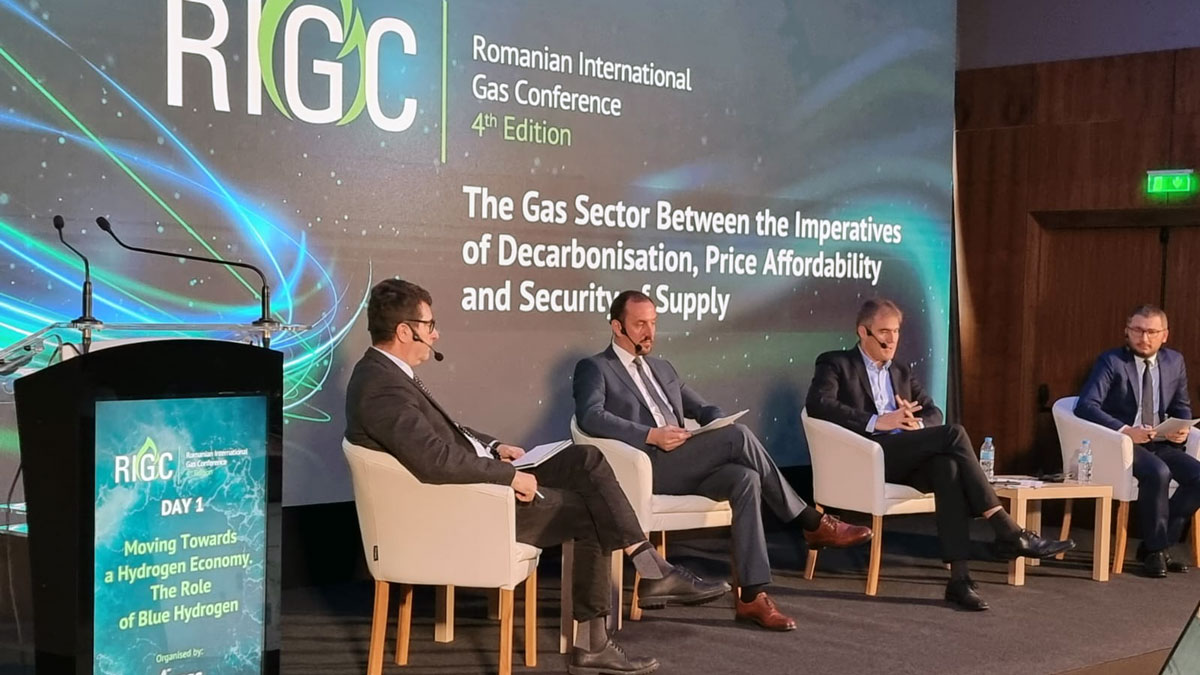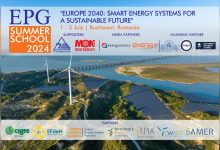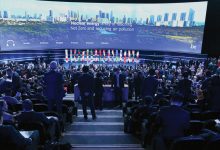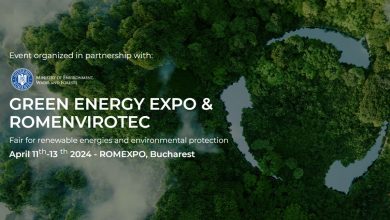RIGC 2021 Day 1
Moving Towards a Hydrogen Economy: Clean H2 Valley in Romania
The 4th edition of the Romanian International Gas Conference (RIGC) organized by the Oil and Gas Employers’ Federation (FPPG) and supported by the Energy Policy Group (EPG) focuses on the challenges faced by the natural gas sector in the new era of energy transition. Given the concerns of security of supply combined with the imperative for decarbonization and price affordability, this international debate brings together leading industry experts to tackle critical issues and implications for the energy industry.
“THE NATURAL GAS SECTOR BETWEEN THE IMPERATIVES OF DECARBONIZATION, PRICE AFFORDABILITY AND SECURITY OF SUPPLY” is an event dedicated to sustainable development strategies of companies in the oil and gas sector, focusing on the actions of the major players in order to harmonize with the EU Climate and Energy Directives.
The conference, comprising three panels – ‘Moving Towards a Hydrogen Economy: The Role of Blue Hydrogen’; ‘The Importance of Natural Gas in the Romanian Energy Transition’ and ‘Rising Energy Prices and Security of Gas Supply’, takes place in Bucharest from 13th to 15th of December.
The agenda of the conference includes topical subjects, strategic for the natural gas sector – natural gas as transition fuel, hydrogen-based decarbonization technologies, the Carbon Capture Storage technology, as well as an analysis of the reasons for the unprecedented increase in gas prices this winter.
Moving Towards a Hydrogen Economy: The Role of Blue Hydrogen
During the first session of the conference, the panellists discussed about the technologies to help Romania on its path to decarbonisation – CCS and Hydrogen, the EPG study’s results on Romania’s potential to produce Hydrogen and the elements to be included by the authorities in the National Hydrogen Strategy.
Participating in the debate, Tudor Toncea – Director within Romania’s Ministry of Energy, pointed out: “The goal of the Ministry of Energy is to complete the national hydrogen strategy within one year, respectively the first quarter of 2023”. In terms of funding, the strategy will benefit from funds from the National Recovery and Resilience Plan – NRRP, the official also mentioned. The process will start in early 2022, after collecting the necessary data. It will be a process open to involvement by all stakeholders.
The Ministry of Energy plans to develop a national strategy for the use of hydrogen in energy, industry, and transports, to the extent of the increasing importance assigned by the European Commission to this energy source, in the effort of reducing carbon emissions. Decarbonization of the energy sector in Romania, phasing-out coal and transition to natural gas and renewable energy will allow reaching the climate, energy, and environmental targets, Tudor Toncea said.
An articulate strategic vision leading to clean H2
Cristian-Silviu Busoi – Chair, Committee on Industry, Research & Energy – pointed out that including the ITRE Committee takes into account Blue H2, in the context of EU’s strategic objective – achieving carbon neutrality by 2050. H2 gains more and more attention, although it continues to represent a small portion of the energy mix at the European level. “We need a real H2 market, but for now we don’t have enough resources to produce hydrogen”, the MEP said. In terms of use, there are promising prospects in the aviation industry, added Cristian Busoi.
Romania can become an important player in the hydrogen market, by using the existing infrastructure, he claims. However, an articulate strategic vision is needed, leading to clean H2, as well as tools and incentives in this regard.
Covering every step in the hydrogen value chain
A useful example to follow was provided by Oliver Pfann – President of East Europe & Middle East Region, Linde Gas, a leading global industrial gases and engineering company. Linde is able to cover every step in the hydrogen value chain from production and processing through distribution and storage to everyday industrial and consumer applications, Oliver Pfann claims. Their product portfolio includes liquefaction, storage, distribution, applications.
The largest production operated by Linde is the 24 MW electrolyser for the production of green hydrogen at the Leuna Chemical Complex in Germany, built by ITM Linde Electrolysis, a joint venture between Linde and ITM Power. The facility will produce 3,200 t/y of green hydrogen using renewable energy, which will be used to supply hydrogen to Linde’s industrial customers through existing pipelines. The facility will begin hydrogen production in the second half of 2022. Carrying out a wide range of activities related to H2, Linde is involved in 12 Blue H2 projects in Europe.
In Romania, Linde owns together with Solaris 100 H2 fuelling stations for buses. Linde owns 2 mobile H2 fuelling stations in Timisoara; at the moment, there are no fixed H2 fuelling stations in Romania, due to limited demand.
OMV Petrom to invest in H2
Ionut Ciubotaru – Vice President for Business Development, OMV Petrom, summarized in his presentation the most important messages of company’s decarbonization strategy. In the second half of the decade, the company will intensify investments to seize opportunities in carbon capture and storage, as well as in hydrogen, which are anticipated to have a significant contribution to the decarbonization of the country.
H2 is one of the solutions for hard-to-decarbonise industries, as well as to decarbonise gas, he underlined. That’s why for Romania, blue H2 is a must to cover the total demand of H2, giving the high amount of green power needed to produce 1 ton of green H2. Together with its partners, OMV Petrom is trying to develop projects focusing not only on production, but also on demand – a particularly important aspect to consider.
Blue H2 is essential in Romania in its energy transition, in combination with green H2. Romania has the resource for blue H2 production and capabilities, building on the oil and gas industry legacy and the Black Sea gas. Romania has plenty of options for CO2 storage, considering the range of depleted oil and gas reservoirs, but also saline formations. Given the Black Sea resources, Romania has the potential to become the 1st natural gas producer in Europe, Ionut Ciubotaru also noted.
“We can turn Romania into the Clean H2 Valley for Europe,” said Ionut Ciubotaru. Of course, the process involves a combination of several factors.
But switching to a reduced footprint is not possible immediately, due to various limitations, such as demand for water within electrolysis, the representative of OMV Petrom warns. Another obstacle is the fact that the use of H2 for power generation involves processes with an energy efficiency of less than 40%.
Regarding fugitive methane emissions, OMV Petrom offered to participate in research projects at European level in this field. It should be noted that in the case of new equipment, used in the Neptun Deep project, the fugitive emission rate is close to zero.
Clean H2 Valley in Romania
The Romanian region of Dobrogea has all the prerequisites for becoming a clean hydrogen valley, states Mihai Balan – Chief Technology Officer, EPG.
The EPG study results show that there are key factors that should turn Dobrogea into Romania’s flagship hydrogen initiative: an exceptional potential for producing hydrogen from onshore and offshore renewable energy; regional hydrogen demand in refineries, steel plants, and multiple transport modes; a strategic role that can be played by the Port of Constanta.
Elements of a Strategy estimates that in Romania more than 1.4 GW of electrolysers need to be installed to reach the Fit for 55 targets for clean hydrogen in industry and transport. Given the country’s renewable potential, it is estimated that clean hydrogen could be produced in Romania for less than EUR 2.5/kgH2.
Indeed, Dobrogea is Romania’s renewable energy pole, offering the highest renewable energy potential, and hosting most of the country’s 3 GW of onshore wind capacities, which are expected to further expand both onshore and offshore. As shown by the EPG study, Romania has a significant offshore wind potential in the Black Sea, with an estimated total natural capacity of 94 GW, corresponding to 239 TWh of Annual Energy Production (AEP).
Moreover, the 1.4 GW of capacities from the Cernavodă nuclear power plant, also located in Dobrogea, are expected to be expanded by an additional two new reactors. All of this will happen in an area with limited local energy demand, leading to potential grid congestions. Transforming some of this decarbonised electricity in clean hydrogen could contribute to both alleviating the stress on the grid and further enabling the region’s decarbonisation.
Significant hydrogen demand can come from industry, especially the existing refinery (Petromidia), steel mill (Liberty Galati) and cement factory (LaFarge Medgidia), from district heating systems (Constanta, Galati, Tulcea, Braila), and from transport – maritime (Ports of Constanta, Tulcea and Mangalia) and aviation (Mihail Kogălniceanu International Airport).
The Port of Constanta can become the ideal gateway for hydrogen export. Indeed, it represents one of the most valuable assets for this endeavour. By synergising the offshore wind and hydrogen value chains, it could grow into a regional pole of decarbonisation for the entire Black Sea basin. The shipyards in Constanta, Mangalia, Tulcea, Braila or Galati can also contribute by building or retrofitting ships to run on clean hydrogen and hosting refuelling stations.
Turning the Dobrogea Hydrogen Valley into reality can bring great national benefits.
Romania, particularly Dobrogea, can attract a considerable part of investments at EU level by 2030, which will total EUR 24-42 billion for electrolysers, and EUR 22-40 billion for renewable sources.







